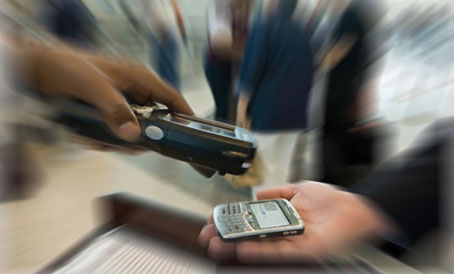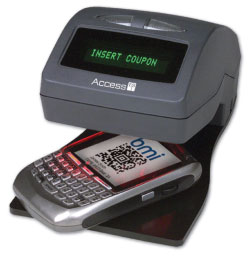
The vision behind BCBP is to reduce queues at airports and reduce airline costs associated with check-in processes, while offering more convenience to the passenger. IATA’s action plan is three-fold – to provide implementation support to airlines to become BCBP capable, ensure service providers are BCBP enabled and facilitate dialogue between airlines and airports.
The benefits of BCBP will be felt by passengers, airlines and airports. Customers will be empowered to print their own boarding pass at home or at the office and thus avoid queues for check-in; airlines will be able to provide one boarding pass for the entire journey and will benefit from cheaper related equipment and maintenance and from the elimination of ATB paper; and airports will be able to improve their use of airport space, lower their equipment related costs and increase throughput of constrained areas.
Good progress is being made towards 2D bar coded boarding passes – of IATA’s 200 member airlines, 154 have already implemented the 2D standard. “All IATA members will be compliant by the end of 2008. The next phase, to the end of 2010, is to get all airports to update their equipment, such as bar code scanners at the gate,” said Leopold.
He is confident that both the 2008 and 2010 targets will be achieved. IATA surveyed airports last year; 60% of those surveyed were 2D bar code capable. “That doesn’t mean we’re there yet, but there has been good progress on the airport side,” said Leopold.
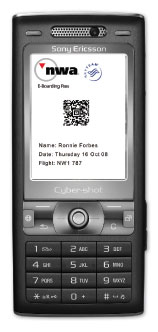
Paperless Boarding Pass pilot
Airlines are using 2D bar codes in Canada, the UK, Spain, Germany and Japan. Around 12 carriers have implemented 2D bar code technology on mobile phones. The traveller can either use mobile check-in by browsing the airline website on their phone – at the end of the check-in process a 2D bar code is displayed, or they can have their boarding pass delivered to their phone after checking-in on a computer. The passenger does not necessarily have to do the whole process on their phone.
Mobile check-in pilots are currently taking place in the US. “The Transportation Security Administration (TSA) authorised pilots of BCBP for mobile phones for Continental Airlines, Delta and Northwest out of six airports,” said Leopold. “The pilots began in October/November 2007. We have had feedback from passengers, who say it is very convenient. There is a very good read rate – it has been a success so far.”
Most recently, the TSA and Continental Airlines expanded the rollout of the Paperless Boarding Pass pilot program to Ronald Reagan Washington National Airport, Newark International Airport and Logan International Airport in Boston. Each paperless boarding pass displays an encrypted two-dimensional bar code along with passenger and flight information that identifies the traveler. TSA travel document checkers use hand-held scanners to validate the authenticity of the paperless boarding pass. “The deployment of the paperless technology, with Continental Airlines, signifies TSA’s ongoing commitment to develop and execute new technologies within aviation while enhancing security,” said Karen Burke, federal security director, Ronald Reagan Washington National Airport. “These paperless boarding pass pilots are a significant step towards ensuring that fraudulent boarding passes cannot be used to gain access to the sterile side of airports.”
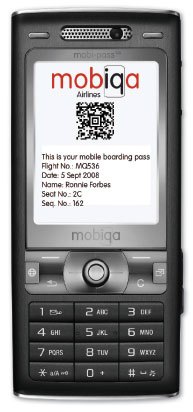
TSA created the concept of how to scan the paperless boarding passes and Continental Airlines developed an implementation plan that involved encrypting the paperless boarding pass to ensure authenticity. “We are pleased to take part in this pioneering concept that provides enhanced security and customer service to our passengers,” said Mark Bergsrud, Continental Airlines senior vice president, Marketing Programs and Distribution. “Continental Airlines is committed to innovation and leveraging technology to the benefit of our customers.”
bmi trials Access 2D bar code readers
bmi started trials in May of Access’ BGR120S, a 2D bar code boarding gate imager that reads bar code symbols from the displays of mobile phones and PDAs. The Access imagers, which are already successful in reading paper-based home printed boarding passes, are used together with Real Time Engineering’s FirstPass mobile boarding pass platform.
The imager reads bar codes face-up, which makes it faster and easier to capture as the agent can easily place the bar code in the target zone and ensure the backlight has not turned itself off.
The QR, DataMatrix or Aztec bar codes are simply sent by the airline over the phone network to customers’ mobile phones as a multimedia message (MMS) or WAP push via a link.
Access also provided a complementary receipt printer, which the trial has shown can double the speed of boarding. Printed receipts may be needed when boarding an aircraft that is re-fuelling. The printer can be configured to produce two receipts, one for the passenger for the final stage of the boarding process and one for the airline for passenger reconciliation, where required by the airline.
Alaistair Deacon, Real Time Engineering’s technical director, said: “This technology will become popular with business travelers who will be able to check-in via their mobile phones with no need to queue at the airport. It cuts costs for airlines too, and the same technology is used to send passengers immediate flight updates.”
David Menezes, bmi’s senior product and development manager, said: “FirstPass was attractive as a simple, effective solution that our passengers would find easy to use. The trial has exceeded our expectations and has been extremely popular with passengers. We believe that the technology will go from strength-to-strength over the next few years. The bar code readers have proven themselves to be very robust and reliable in operation, and the accompanying receipt printers are invaluable in saving us further time and expense in boarding passengers.”
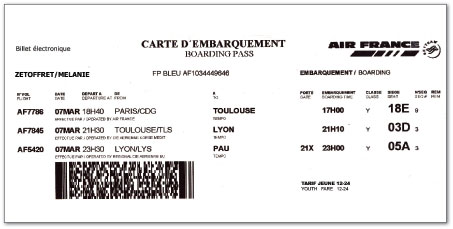
Improved passenger flows
There are seven touch points at airports where 2D bar codes are scanned in order to improve passenger flows and airline operations. This can be done at the gate, at security, to enter a lounge, or a fast track lane. “That is to maximise use of the bar code and track passengers around the airports. It means airports can provide better services, as they know how many passengers there are and when to expect them at the gate,” said Leopold.
With airlines all using the same one-code data, it is very convenient for interlining and security. “Airlines can share equipment, which is beneficial for automation. Boarding passes can be delivered via the web and mobile, so there is direct delivery of the boarding pass,” said Leopold.
It will also enable much better use of the check-in area, allowing desks to be converted into bag drops, for example, and it will be possible to process more passengers in the same space.
The next step is NFC (Near Field Communications), which can be used to store data such as a boarding pass. The scanner recognises data on a chip embedded in the phone. The phone does not need to be switched on in order for the chip to communicate the data. The next step is to work towards establishing a standard.
Northwest and Mobiqa launch E-Boarding Pass
Northwest Airlines, in partnership with Mobiqa, has launched a mobile phone boarding pass called E-Boarding Pass, which is available to passengers travelling from Indianapolis to cities within the US when checking-in using a PC or handheld mobile device. The E-Boarding Pass incorporates passenger travel details on an industry standard bar code that is sent directly to handheld devices and mobile phones in the form of an MMS, email or WAP Push/link message.
“In 2007, Northwest Airlines began allowing customers to use their handheld devices to check-in for a flight. Now they can take that one step further by eliminating the need for a paper boarding pass,” said Al Lenza, Vice President Distribution and E-Commerce.
The new E-Boarding Pass also helps Northwest Airlines in its efforts to eliminate unnecessary paper waste. It is estimated that the airline eliminates 20 million tickets a year by going paperless for ticketing (E-ticket). This new feature now expands the paperless concept to boarding passes.
Mobiqa can deliver a 2D mobile bar code to a wide variety of mobile devices. Unlike the traditional one-dimensional bar code, the 2D mobile bar code allows a much larger volume of travel data to be embedded in an industry standard bar code. This data is scanned by Northwest devices to provide boarding pass authentication at security checkpoints and boarding validation at the gate. Northwest, in cooperation with the Transportation Security Administration, plans to expand the E-Boarding Pass option to additional cities upon successful completion of the test.
Nick Rankin, CEO, Mobiqa, said: “Offering one of the world’s largest airlines the ability to provide paperless boarding passes to their passengers is an important evolution in airline boarding logistics. With today’s mobile generation, we strongly feel that Northwest Airline’s mobile E-Boarding Pass offering will make for a more convenient, environmentally friendly means of checking-in and boarding a flight. We are delighted to be working with Northwest on this significant mobile boarding pass initiative and are confident that their passengers will make full use of this innovative new service.”
